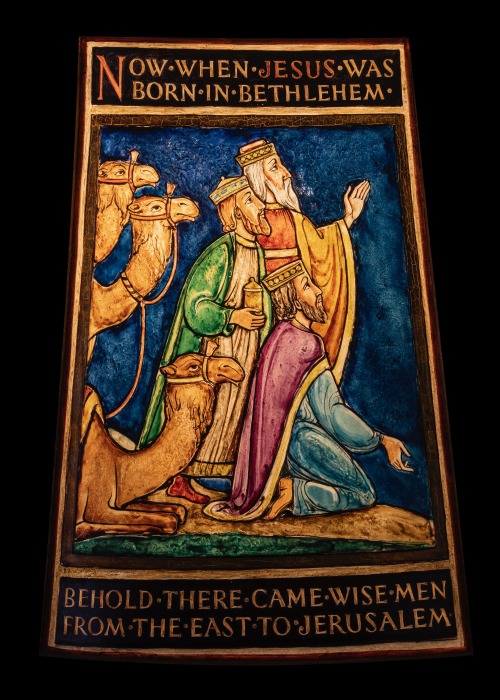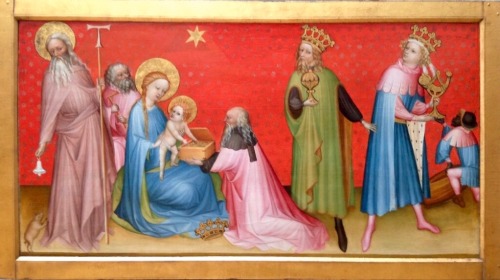#adoration of the magi
ADVENT CALENDAR DAY 16
This panel from a plexiglas lampshade, painted by Frank Snyder in the 1930s or 1940s, features an illustration of the Journey of the Wise Men. Glencairn Museum, Bryn Athyn, PA, 11.OP.02.
Glencairn’s family Chapel has a floor lamp with a handcrafted, six-paneled lampshade depicting scenes from the story of the birth of Jesus Christ. Each one of the illustrations is accompanied by a biblical quotation. In the panel pictured here, the Wise Men are depicted at night with their camels, following the Star of Bethlehem: “Now after Jesus was born in Bethlehem of Judea in the days of Herod the king, behold, wise men from the East came to Jerusalem, saying, ‘Where is He who has been born King of the Jews? For we have seen His star in the East and have come to worship Him’” (Matthew 2:1–2).
Raymond Pitcairn commissioned artist Francis (“Frank”) Eugene Snyder to design and create this lampshade in the 1930s or 1940s when Glencairn was being decorated. It is made from plexiglas panels, which Synder painted with oils. By using a variety of media, he was able to achieve the appearance and texture of stained glass when the light is turned on.
Every day, from December 1 through December 25, a new work of Nativity art from the Glencairn Museum collection will appear on the home page of our Advent calendar (Follow the Star: A 2021 Advent Calendar). To receive these in your newsfeed, follow our social media (Facebook, Instagram, Twitter, Tumblr).
Post link
ADVENT CALENDAR DAY 12
Stained-glass panel with the Adoration of the Wise Men, made by Lawrence Saint around 1919. Glencairn Museum, Bryn Athyn, PA, 03.SG.356.
This panel from a Christmas window features the Adoration of the Wise Men. It is part of a two-light, four-panel window designed by stained-glass artist Lawrence Saint around the year 1919. Here Mary holds Jesus on her lap while the Wise Men present the Christ Child with gifts of “gold, frankincense, and myrrh” (Gospel of Matthew 2:9–12).
Lawrence Saint, who had his own stained-glass studio just down the road from Bryn Athyn Cathedral in Huntingdon Valley, worked as a glass artist for the Cathedral early in his career. He later became nationally recognized for his stained-glass work on the National Cathedral in Washington, D.C. This Christmas window was originally located in Bryn Athyn Cathedral, but was later placed in storage, where it remained until it was rediscovered in the late 1980s.
Every day, from December 1 through December 25, a new work of Nativity art from the Glencairn Museum collection will appear on the home page of our Advent calendar (Follow the Star: A 2021 Advent Calendar). To receive these in your newsfeed, follow our social media (Facebook, Instagram, Twitter, Tumblr).
Post link
In honor of the Feast of the Epiphany
Adoration of the Magi with Saint Anthony Abbot, About 1390-1410 @thegettyFranco-Flemish Master
Against a magnificent red backdrop decorated with a floral motif (an allusion to divinity), the Christ child receives the Magi and grasps the gold coins offered by Caspar, accepting his kingship. The while turban of the youngest Magi and the black page refer to the Three Kings’ distant lands. While the animated Virgin and Child group appeared throughout Europe at the time this panel was painted, the elegant figures, refined faces, and lively curls are hallmarks of the major Flemish artists working for the Burgundian court in Dijon. Saint Anthony, identified by the frolicking pig at his feet (pig fat was used as a remedy for certain skin diseases), was a favorite saint in that region, and this paintings was probably intended for a hospital or chapel dedicated to him. *
*Gallery Label
Post link
Pietro Ricchi (Il Lucchesino) (Lucca, 1606-Padua or Udine, 15 August 1675), The Adoration of the Magi, 17th century
Post link




